Adding eels to your aquarium is a great way to add variety to your tank.
These are eerie and fierce-looking creatures that slink and move in an almost entirely unique way. They are truly spectacular to own!
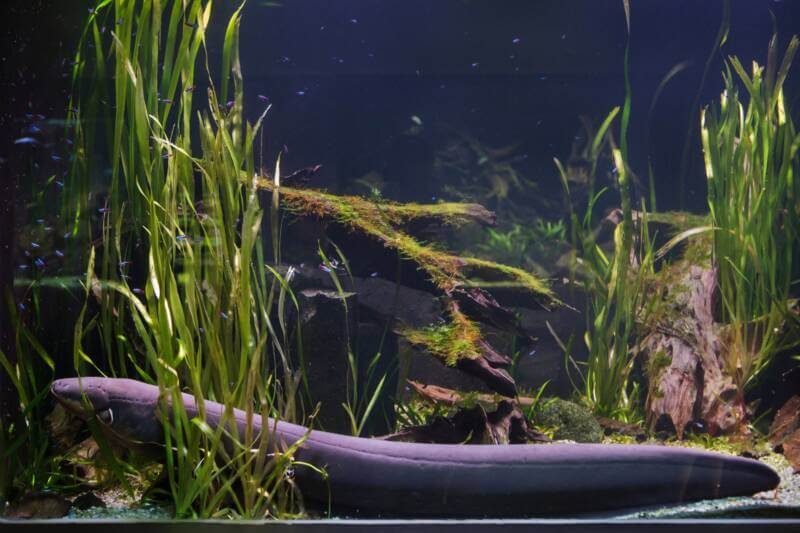
But as such unique creatures, eels also need to be cared for in a particular way.
In fact, it’s not even clear cut as to whether it’s possible to keep true freshwater eels in a tank at all!
In this post, you will find out everything you need to know about freshwater aquarium eels: how to buy them, how to take care of them, and how to ensure they are happy and healthy.
In this article
About Freshwater Aquarium Eels

When it comes to freshwater aquarium eels, one of the most common types to own is the Gymnothorax tile.
This species of eel is also sometimes called the Indian mud moray, gold dust moray, or the snowflake eel (though there are actually two types of “snowflake eel!”).
To look at, these are your stereotypical eels. They are long and snake-like with no fins.
They have piercing eyes on either side of their head and a slightly unusual expression with their mouth agape.
The Gymnothorax also sports a grey-ish hue with several yellow and golden spots on the dorsal and lateral aspects of its body (hence the “gold dust” name).
Other freshwater aquarium eels that you can choose from include:
- Tire track eel
- Fire eel
- Electric eel (!)
- African lungfish
- Asian swamp eel
- Rubber eel
- Reedfish
- Zig-zag eel
- Half-banded spiny eel

Most of these will bring that same typical eel look, which is what a lot of hobbyists are after. But there’s a catch…
Can You Really Keep Freshwater Aquarium Eels?
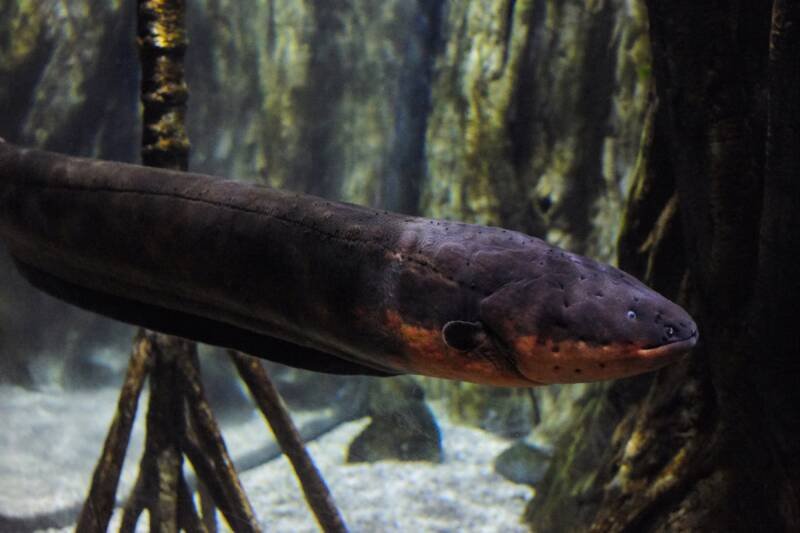
You may have seen freshwater aquarium eels and thought that they looked like a fun pet to own.
What you may not realize though, is that many of these eels are not actually eels.
That’s right: if you get yourself a tire track eel or a fire eel, then you will find that these are not actually eels at all!
Instead, these are “look-alike fish” that appear and behave very similarly to true eels, but are in fact from different families. They are not true eels, but rather “eel-like fish”.
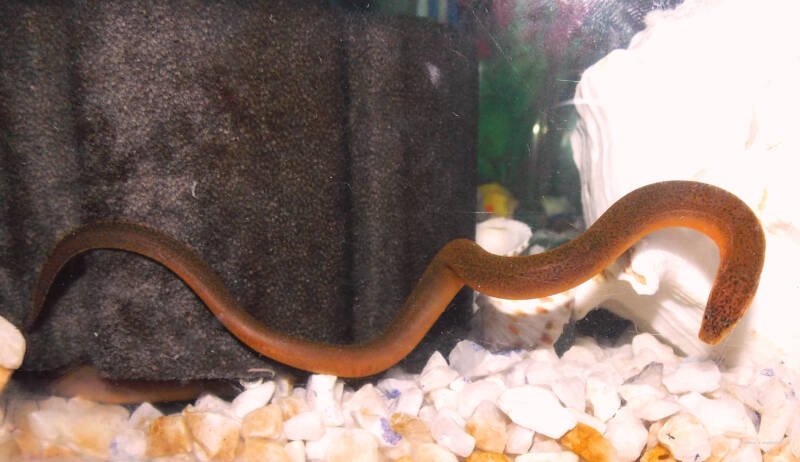
Choosing a tire track eel, or other aquarium eels like these is a good choice because they are able to live in 100% freshwater tanks!
On the other hand, the true eels such as Gymnothorax tile mentioned earlier, will at some point need to migrate to brackish or marine water in order to thrive.
Popular Freshwater Eels
With different freshwater eels having their own requirements, personalities, let’s take a look at some of the most popular breeds.
Keep in mind once again that these are not true moray eels, but rather eel-like fish.
1. Tire Track Eel (Mastacembelus favus)

The tire track eel from the Mastacembelidae family is a very long fish with a slightly shy personality.
They can take a little time to warm up, but once they do, they become more confident making the most of their space.
That said, you should always make sure a tire track eel has somewhere safe and sheltered to hide out.
They need soft substrates such as fine sand or peat, and you should provide them with an old PVC pipe or similar to hide in.
While these guys are a little nervous at first, once they build up the confidence they can also be cheeky! They have been known to steal food right out of the mouths of their tank mates!
When introducing multiple tire track eels into the same tank, it’s important that you do this while they are young.
Your window of opportunity is around 3-4 months, after which point they can become more aggressive.
Keep this in mind when choosing tank mates too: ideally, pick other fish that are equally large and similarly aggressive. A good example would be mature cichlids.

Tire track eels can grow up to 2.5 feet long, which makes them exceptionally large.
Unlike the advice to go for a 55-gallon tank for most freshwater aquarium eels, these guys are going to require at least 125 gallons! In the wild, they are used to roaming several square feet of territory.
These fish require a pH level of 6.5-8, a water hardness of 5-15 gH, and a temperature of 73-82 F.
2. Fire Eel (Mastacembelus erythrotaenia)

Fire eels are the largest of all the spiny eels.
These guys are going to need even more space to roam – up to 180 gallons or even more! That’s because fire eels grow over 3 feet – that’s one meter!
That’s in the wild, however, and they will generally stay a little smaller, around 30 inches (76 cm) when kept in captivity.
These fire eels are a little more social than tire track eels, meaning that they can do well in community tanks.
If they don’t think they can eat another fish, they will generally ignore them!
As with tire track eels, fire eels enjoy burrowing.
These fish are more capable of burrowing in harder substrate though and they LOVE gravel.
They’re also known to dig out plants, so you may wish to focus on floating plants if you plan on keeping this species.
They like dim lighting, and as with most species will appreciate having somewhere to hide. They work particularly well with caves but also like driftwood.
These fish are also very intelligent.
One of the nicest things about fire eels is that they learn to recognize their owners, meaning that they can actually be hand-fed.
They especially like black worms but are actually omnivorous, meaning they will eat vegetables. If you really want to make their day though, give them some live prey!
Aim to keep your water quality at 5-15 gH, and 6.5-8 pH. The temperature should be between 73 and 82F.
3. Zig-Zag Eel (Mastacembelus armatus)
Zig-zag eels look like tire track eels in their youth and are often mistakenly sold as such.
The main difference to look out for then is the unique color scheme.
Zig-zag eels have a very gold-hue and have a distinct zigzag pattern across their dorsal surface.
Tire tracks also have a pattern here, but it typically looks more like lots of Os, rather than the slanting, zebra-like pattern of the zig-zag.
These are once again very large eels, growing up to 35 inches (90 cm) in some cases.
You’ll have plenty of time to buy a bigger tank though, as this species has a phenomenally long lifespan of up to 18 years! (As long as you look after them)
These eels are similar to other eel-like fish. They enjoy hiding, burrowing in sand and gravel, and come out at night.
They are semi-aggressive with other eels, so you should look for fish that have a similar size and temperament.
They have even been known to kill spiny eels!
Zig-zag eels need a tank with a 6.5-8 pH, 5-15 gH, and 73-82 F water quality.
Should You Buy Eels or Eel-Like Fish?
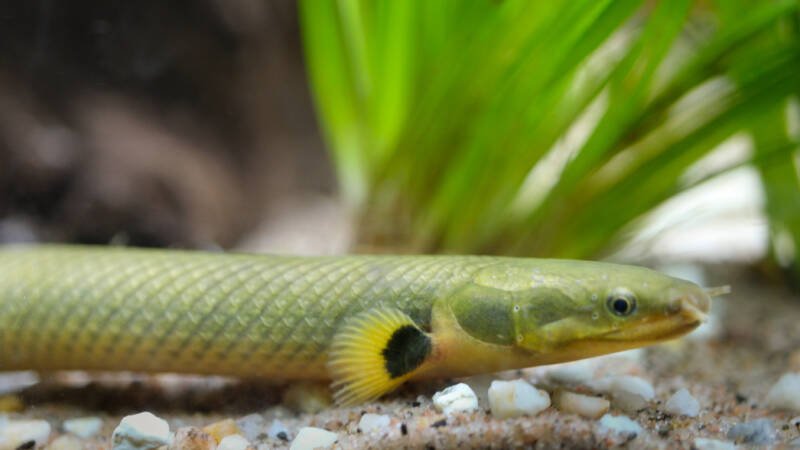
This might make things a little complicated for newcomers, but the key is simply knowing what you’re getting.
Many pet shops and fish stores don’t realize that these true eels are not really freshwater pets and thus continue to sell them as freshwater aquarium eels (of course some do know but happily continue selling them anyway!).
Why is it that these eels are sold as freshwater pets then? How did this start?
The confusion comes from the fact that many of these aquarium eels were originally caught in freshwater.
Importers who sold the fish thus noted this down and they were shipped to the fish stores that way. This began to perpetuate a myth that freshwater moray eels existed.
At the same time, those eel-like fish that we listed earlier likely further added to the confusion.
When buying a “freshwater moray eel” you may be told that your fish has been “bred to thrive in freshwater”.This is unfortunately inaccurate.
If you keep a true Moray eel in freshwater, then it may survive well in the initial months. It may even be quite happy for years!
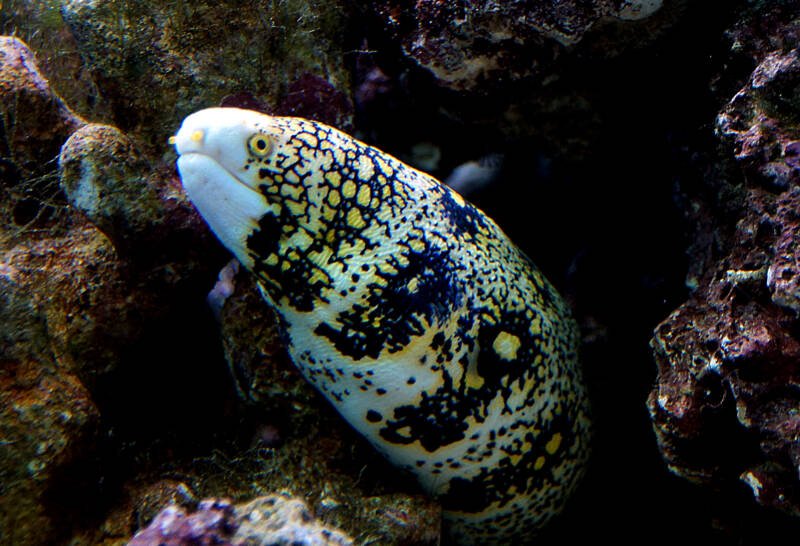
However, over time, those fish will begin to suffer.
These critters are tough in their natural environments, but in freshwater, they may begin to reject food which can lead to starvation.
Even if that doesn’t happen, those fish kept in freshwater are prone to diseases, parasites, and other serious issues.
Moreover, many Moray eels will attack and kill other fish and tank mates first.
The natural habitats of these eels include estuaries and coastal mangrove swamps. The water quality here has a changing salinity (controlled by the tide) but remains roughly similar to marine.
To keep these fish, you need a specific gravity of 1.010, but a fully marine environment will always be preferable.
So: should you consider getting a true eel as a beginner?
There’s no reason not to: but only if you are willing to maintain a brackish or marine tank.
How to Keep Freshwater Aquarium Eels
If you’re happy with a lookalike fish (and you should be, they’re great too!), then you can happily take care of tired track eels, electric eels, and other fish species in a freshwater aquarium.
Here’s what you need to know.
Water Quality
In terms of water quality and pH, freshwater eels vary slightly in their requirement.
Across the various species available, you’ll need alkaline water varying from 6.2-8 pH. For example, a juvenile rubber eel can tolerate water pH up to 8, as can an adult tire track eel.
Due to the variation, you should look up the specific species of eel that you intend on keeping.
That said, in most cases, a tank with a pH between 6.5-7.5 will be suitable for most eels.
In terms of water hardness, you can safely choose 5-15 gH for many eels, but this can go up to 25 gH for some species.
Tank size is also important. 30 gallons will be suitable for many juvenile fish, while 55 gallons is better for the larger adults of many species.
That said, some eels grow extremely large and will demand 180 gallons of space or more!
Water temperature is around 73-82 F but again varies slightly from one freshwater eel to another.
For more information on some of the most popular breeds of freshwater aquarium eels, see the relevant section down below.
Food and Behavior
Whenever you picture an eel, you will tend to think of them emerging slowly from rocks and caves.
This is true to their real-life behavior, as many eels will enjoy hiding in these kinds of places.
This is why it is a good idea to provide your eels with pipes, caves, rocks, and other things that they can hide in and swim around.
Some eels – the spiny eel in particular – also enjoy burrowing.
Make sure to provide ample substrate for them to dig into. Keep in mind that eels are “naked” meaning that they have minimal-or-no scales protecting their bodies.
That means that they can easily scratch themselves when engaging in this behavior. To ensure that doesn’t happen to your pet, choose a very soft substrate such as fine sand.
One of the reasons for this burrowing and cave-exploring behavior is that eels like hiding in dark spaces. Try to avoid shining bright light on your tank!
Eels are nocturnal species. They become most active during the evening and night.
Something else to keep in mind is that some eels like practicing their escape artist routines when you aren’t about.
Though eels are bottom dwellers, they are capable of breathing surface air directly from the atmosphere and they’re also magnificent jumpers in many cases.
One of the most notorious species for this is the swamp eel. They are known to be able to cross large distances on land by jumping! Make sure to keep your tank sealed!
Many species of freshwater aquarium eels and eel-like fish are also social.
These eels will benefit well from having at least one playmate of their own species that they can spend time with. This is particularly true for juveniles.
With that said, overcrowding can be a serious problem for eels. If your tank is not large enough and you have multiple eels, then they can begin to fight over territory.
These are solitary predators and they work best alone! Ideally, choose a tank that offers at least 55 gallons or more space, and then get one or two playmates.
What do Freshwater Aquarium Eels Eat? And What Fish Can Live With Them?
Speaking of the predatory nature of these eels and eel-like fish, it’s also worth noting that they are carnivorous and will prey on smaller fish.
It is usually best to keep them with other fish of their own size unless you want little Nemo to become a snack!
As for what you should be feeding your eels, these will generally eat small crustaceans, mosquito larvae, worms, and small fish.
You can provide these fresh ideally, but eels will also adapt to eating freeze-dried frozen proteins in many cases. Good options include tubifex and bloodworms.
Eels don’t need to eat frequently, and you should only offer them food once a week. Don’t be alarmed if your eel only eats once every few weeks, however!
While all this might sound complicated, the good news is that freshwater eels are actually very hardy and generally easy to take care of.
Freshwater Eel Breeding
Interested in freshwater eel breeding? You may be out of luck!
This is a relatively unknown topic, and it’s not common for eels or eel-like fish to be bred in captivity.
Swamp eels will prefer to breed in shallow waters of swamps and ponds where they lay hundreds of eggs that float to the top and then gather in bubbles.
Freshwater eels from the Anguillidae family live in freshwater but will spawn in the ocean.
Closing thoughts
As you can see then, there are plenty of ways that any aquarium owner can enjoy the exotic, sinister, and exciting look of freshwater aquarium eels!
What they’ll also be getting are hardy fish that love hiding and may even come to recognize their owners. They’re truly fantastic pets.
Just make sure that you know precisely what you’re getting yourself into.
Make sure the eel you buy is genuinely safe in freshwater, that you are happy that your fish is not a “true” eel, and that you know how big they might get!